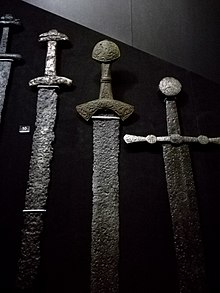Suontaka sword
[2] The grave dates from the late Nordic Iron Age, c. 1040–1174 AD, and it also included another hiltless sword with silver-inlays that was placed directly on the buried corpse.
Ancient DNA analysis found that the individual likely had Klinefelter syndrome, indicated through the presence of XXY chromosomes.
[citation needed] The sword was made with grip and hilt entirely in hollow cast bronze.
[3][verification needed] The sword is considered to be a unique work of art for its time.
[citation needed] Interpretations have suggested the burial is evidence of gender fluidity in the past.
